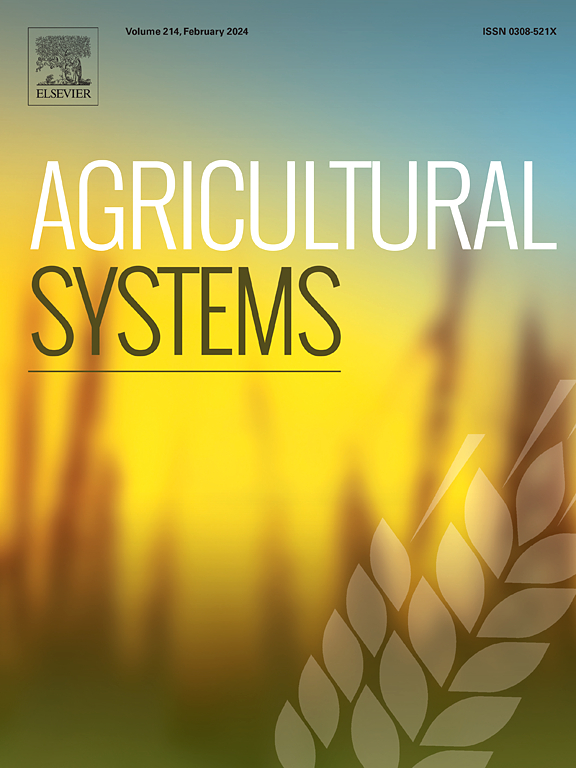农业生态系统产量缺口建模的综合见解:定义、理论框架和多维视角(综述)
IF 6.1
1区 农林科学
Q1 AGRICULTURE, MULTIDISCIPLINARY
引用次数: 0
摘要
潜在产量和实际产量之间的差距是农业面临的一个根本性挑战。缩小这一差距对于提高耕地生产率至关重要,从而在不扩大农业足迹的情况下确保可持续粮食安全。本研究探讨了产量缺口的概念及其在提高单位面积作物产量方面的关键作用,这是在面对不断增长的人口时满足全球粮食需求的必要战略。目的对产量缺口评估方法进行综述和分析,强调其在提高农业生产力中的重要意义。重点是评估各种产量缺口评估方法的优势、局限性和应用,特别强调全球产量缺口图集(GYGA)协议,以增强研究结果在不同农业系统中的相关性和适用性。方法综述了作物模拟模型(cms)和卫星影像技术等5种广泛应用的产量缺口评估方法。本研究考察了全球范围内这些方法的方法、优势、局限性和值得注意的应用。它还讨论了先进的数据收集和分析技术的集成,以克服诸如数据稀缺和结果不一致等挑战。结果与结论本研究确定了产量缺口研究面临的主要挑战,包括可靠数据的缺乏,以及在相似条件下不同方法产生的结果不一致。这些问题给农业决策者和农民带来了重大挑战,可能会降低产量差距分析的实际效用。该研究强调需要改进标准化和方法整合,以提供可靠和可操作的见解。报告还强调了应对气候变化挑战的产量差距方法的演变,以及制定有效适应和缓解战略的必要性。跨方法比较还揭示了一致的关键产量差距决定因素。这篇综合综述对各种产量差距评估方法的历史、方法、优缺点提供了有价值的见解。它讨论了它们的演变和未来的挑战,为整合这些方法以推动可持续农业实践提供指导。研究结果有助于在持续的环境和社会经济压力下做出更好的农业决策,从而促进全球粮食安全。本文章由计算机程序翻译,如有差异,请以英文原文为准。

Comprehensive insights into modeling yield gap in agroecosystems: Definitions, theoretical framework, and multidimensional perspectives (a review)
CONTEXT
The yield gap—the difference between potential and actual yield—represents a fundamental challenge in agriculture. Closing this gap is crucial for increasing the productivity of arable land, thereby ensuring sustainable food security without expanding the agricultural footprint. This study explores the concept of the yield gap and its critical role in boosting crop production per unit area, a strategy essential for meeting the global food demand in the face of a growing population.
OBJECTIVE
This study aims to review and analyze methodologies for assessing the yield gap, highlighting their significance in improving agricultural productivity. The focus is on evaluating the strengths, limitations, and applications of various yield gap assessment methods, with a particular emphasis on the Global Yield Gap Atlas (GYGA) protocol to enhance the relevance and applicability of findings across different agricultural systems.
METHODS
Five widely utilized yield gap assessment methods were thoroughly reviewed, including crop simulation models (CSMs) and satellite imagery techniques. The study examines the methodologies, strengths, limitations, and notable applications of these methods globally. It also discusses the integration of advanced data collection and analysis techniques to overcome challenges such as data scarcity and inconsistencies in results.
RESULTS AND CONCLUSIONS
The study identifies key challenges in yield gap research, including the scarcity of reliable data and the inconsistencies from different methodologies producing divergent results under similar conditions. These issues pose significant challenges for agricultural decision-makers and farmers, potentially reducing the practical utility of yield gap analyses. The study emphasizes the need for improved standardization and methodological integration to provide robust and actionable insights. It also highlights the evolution of yield gap methodologies to address climate change challenges and the need for effective adaptation and mitigation strategies. A cross-method comparison also revealed consistent key yield gap determinants.
SIGNIFICANCE
This comprehensive review provides valuable insights into the history, methodology, strengths, and weaknesses of various yield gap assessment methods. It discusses their evolution and the challenges ahead, offering guidance on integrating these methodologies to drive sustainable agricultural practices. The findings contribute to global food security by informing better decision-making in agriculture amidst ongoing environmental and socio-economic pressures.
求助全文
通过发布文献求助,成功后即可免费获取论文全文。
去求助
来源期刊

Agricultural Systems
农林科学-农业综合
CiteScore
13.30
自引率
7.60%
发文量
174
审稿时长
30 days
期刊介绍:
Agricultural Systems is an international journal that deals with interactions - among the components of agricultural systems, among hierarchical levels of agricultural systems, between agricultural and other land use systems, and between agricultural systems and their natural, social and economic environments.
The scope includes the development and application of systems analysis methodologies in the following areas:
Systems approaches in the sustainable intensification of agriculture; pathways for sustainable intensification; crop-livestock integration; farm-level resource allocation; quantification of benefits and trade-offs at farm to landscape levels; integrative, participatory and dynamic modelling approaches for qualitative and quantitative assessments of agricultural systems and decision making;
The interactions between agricultural and non-agricultural landscapes; the multiple services of agricultural systems; food security and the environment;
Global change and adaptation science; transformational adaptations as driven by changes in climate, policy, values and attitudes influencing the design of farming systems;
Development and application of farming systems design tools and methods for impact, scenario and case study analysis; managing the complexities of dynamic agricultural systems; innovation systems and multi stakeholder arrangements that support or promote change and (or) inform policy decisions.
 求助内容:
求助内容: 应助结果提醒方式:
应助结果提醒方式:


